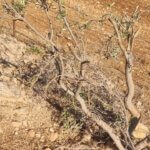Israeli army drills displace hundreds in rural Palestinian communities
Published by Maan News
BETHLEHEM (Ma’an) — Hundreds of Palestinian villagers in the northern Jordan Valley have been forcibly displaced this week as Israel conducts unprecedented military drills around villages near Tubas.
The army drills, which began on Sunday, have seen a large-scale mobilization of Israeli military vehicles around villages east and south of Tubas, with the Jordan Valley Solidarity group estimating that hundreds of tanks, helicopters, and heavy machinery have been moved into the area.
The exercises are taking place in a closed military zone east of Tubas in Area C — also home to several large Palestinian communities — and have so far displaced 18 families from Khirbet Humsa, 30 families from Hammamat al-Maleh, five families from Frush Beit Dajan and 13 families from Ibziq, JVS says.
Israeli military officials forced some of the farming communities to sign papers one week ago obliging them to leave their homes from May 3 until May 7, while other communities in al-Hadidya have been put on standby to be evacuated, meaning the length of the military drills is as yet undetermined.
Villagers say that if they refuse to leave during the drills the Israeli army will simply destroy their homes.
Either they leave or are forced to leave,” Sarah Cobham, a volunteer with JVS told Ma’an from al-Hadidya, the buzz of military activity audible in the background.
“When people have to leave their homes they are given no support, so all they can do is stay with other people they know in the area and find people to help look after their animals. There is no compensation.”
Dust, explosions, smoke, and the sound of gunfire permeate the landscape as tanks and military vehicles launch artillery fire in the area, with the farming and herding communities left to worry about the crops and livestock that they left behind, primary sources of income for most families.
And their fears are well justified.
On April 28, over 3,000 dunams of crops and trees were destroyed after a fire broke out due to army drills in the area, while 5,000 dunams of land were burnt near al-Hadidya on May 4 due to heavy military fire, JVS activists said.
The military drills involve over 50 tanks, heavy artillery fire, and targets set up, most notably in the village of Bardala, for military aircraft to bomb, meaning that extensive damage to the natural landscape and agricultural crops is inevitable.
Cobham, who was in Khirbet Humsa before the mass evacuation of villagers, said the atmosphere was “very, very tense,” with families extremely angry and worried about what will happen to them.
“It’s about the uncertainty in peoples’ lives. They don’t know how long the training is going on for, or if or when the road will be blocked, or when they can move. That’s a major part of the impact.”
“This military training right next to Palestinian homes is clearly part of the (Israeli) occupation’s attempts to pressurize people to leave their land.”
‘Depopulated of Palestinians’
Israeli military training exercises in the Jordan Valley have increased dramatically since 2012 and are one of many tools used to forcibly displace rural Palestinian communities, JVS says, part of a historic process of creeping annexation of the valley by Israel’s military.
Forming a third of the occupied West Bank and with 88 percent of its land classified as Area C — under full Israeli security and administrative control — the Jordan Valley has long been a strategic area of land unlikely to return to Palestinians following Israel’s occupation in 1967.
Jeff Halper, co-founder and director of the Israeli Committee Against House Demolitions, told Ma’an that since 1948 Israel has viewed the Jordan Valley as its “security border” and there is no possibility, even within the framework of a two-state solution, that it will revert back to Palestinians.
“The Jordan Valley is special in that it is seen as central to Israel’s security and from that point of view its non negotiable. There has been a process of Judaization and it has largely been de-populated of Palestinians.”
Halper says that before Israel’s 1967 occupation, around 250,000 Palestinians lived in the Jordan Valley, a number that today only stands at 50,000, most of whom live in Jericho.
Mass house demolitions, settlement construction, and the establishment of Israeli agricultural production zones have essentially replaced the Palestinian population, with any remaining land declared as closed military areas.
“Military activities have always been a cover for displacement. Over time they will pass the land over to settlers. It’s a layered process,” Halper said.
The unpredictability of the training drills leaves rural Palestinian communities in the Jordan Valley anxious about when they will be displaced, and whether the next time will be permanent.
Palestinians in the Jordan Valley are one of the most vulnerable groups to displacement, with over 60 percent of the 6,000 Palestinians forcibly displaced since 2008 belonged to herding or Bedouin communities, according to the Office for the Coordination of Humanitarian Affairs (OCHA).
Rashid Sawaftah, coordinator of the Jordan Valley Solidarity, told Ma’an that the communities are essentially under siege and forced to put their lives on hold while the drills take place.
Unable to return to their homes, and with most roads blocked, families take refuge under trees and in the open while they wait to return amid an uncertain future.
“Training exercises, all this of kind of violence, affects all the families,” he said. “People are very sad and the children cannot understand this kind of pressure and insecurity.”
“It is a way to transfer people from the land.”




